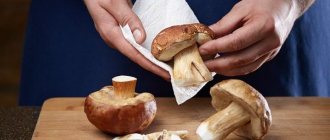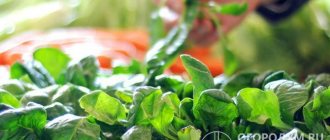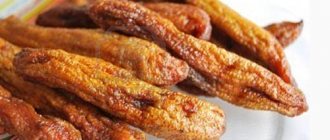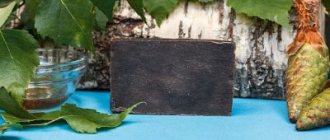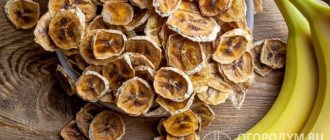Bananas are a delicious fruit, which also spoils quickly. It happens that you bought too much fruit and did not have time to eat it in a few days. To prevent bananas from spoiling, you can freeze them to extend their shelf life.
To preserve the taste of bananas and banana products, it is important to know how to properly store them in the refrigerator. You can freeze the fruit whole, skin included, or peel it in advance.
Why you need to freeze bananas
Bananas are a healthy, delicious and conveniently portable fruit. It relieves hunger and does not take up much space: you can take it with you on the road or to an important event, the duration of which involves snacking. Unfortunately, the fruit tends to ripen quickly. And bananas don’t last long. Within a few days they begin to turn into mush. If you have overripe bananas, you don't have to make pancakes or throw them away, you can just freeze them.
Method number 1. Puree and freeze in one layer
- Time : 15 min
- Rating: 3/10
About this method . Peeling bananas and mashing them for future use is a very common technique in bakeries. The puree can be measured and frozen in small bags for specific recipes. All the mashing work is done ahead of time and you have frozen mashed bananas ready to go!
Results . Even though we were skeptical about this method, we had to try it. This option is best suited for baking and is not suitable for smoothies at all. The pre-mashed bananas couldn't be measured per smoothie and had a slightly starchy texture (even though the original bananas were perfectly ripe).
Methods for storing bananas in the freezer
There are several ways to store bananas in the freezer. The method you choose will depend on how you plan to use them later. It is best to freeze bananas as soon as brown spots begin to appear on the peel.
You can freeze unpeeled bananas. But this method has obvious disadvantages. Of course, you save time on peeling food, especially if you plan to put a lot of bananas in the chamber. But when you take the fruit out of the freezer, you'll likely be disappointed and upset. When they freeze with their skins on, they turn brown and soft. Bananas are good to eat, but the peel in this state is more difficult to remove.
Selection and preparation of bananas
Freezing is carried out with ripe or slightly overripe fruits. Green fruits are not suitable for freezing.
Before putting bananas in the freezer, be sure to wash them well.
This process is considered quite appropriate considering that they have undergone extensive transportation and repeated transfers to supermarket shelves. Leave the washed fruits until completely dry.
Freezing whole bananas
This method is best if you plan to make baked goods or banana smoothies. Peel the bananas. Place them in a bag or container and place them in the freezer. Don't forget to mark the container with the date the fruit was frozen.
If there is little snow, there will be no harvest: December 16 is Ivan the Silent Day
Smooth and fresh skin: dermaplaning, or why a woman needs to shave her face
The money tree pleases with lush flowering: my secret is in caring for the leaves
Frozen bananas can be immediately put into a blender to make a smoothie without waiting for them to thaw. If you plan to bake pancakes or a pie, defrost the fruit first.
How to defrost frozen bananas?
You don't need to defrost frozen banana slices to make a smoothie; they replace ice and keep the smoothie cool while blending. But if you plan to use frozen bananas for baking, here are 3 easy ways to defrost them.
Fridge
Transfer the amount of bananas you want to defrost from the freezer bag into another airtight container (if you are thawing mashed bananas, you can skip this step). Place the portion packet in a bowl and transfer to the refrigerator. They will melt overnight and be ready to use in the morning.
Water
Place the bananas you want to defrost in a sealed plastic bag (you don't need to do this for mashed bananas). Fill the bowl 2/3 full with warm water. Dip the bag into water and the sliced bananas or mashed plantains will melt in 5-7 minutes. Bananas cut in half will take a little longer, so you may need to drain the bowl and refill with warm water.
Microwave
Transfer bananas to a microwave-safe plate. You don't plan to cook the bananas, so let them sit for just 2 minutes using the Defrost setting. If your microwave does not have this option, set it to the lowest setting instead. Do not try to heat mashed bananas in a plastic bag in the microwave as the plastic may melt!
Articles on the topic
How to dry bananas correctly - in the air, in the oven, in the dryer and in the microwave
Banana peel fertilizer: preparation methods, how to use
Is it possible to eat bananas at night? The answer is here!
Storing Sliced Bananas
This method makes it easier to measure the required amount of ingredients for making smoothies or other dishes and drinks. Peel the bananas. Cut the fruit into slices one to two and a half centimeters thick. It is not necessary to measure the slices with a ruler.
Place banana slices in a single layer on a baking sheet lined with parchment or wax paper. Place it in the freezer for about two hours. After the specified time has passed, check whether the fruit is frozen or not. If the slices are still soft, place the baking sheet in the refrigerator for another hour or two. Place the frozen slices in a food storage bag or container and label it with the date and place it in the freezer. Use banana slices as needed.
Calorie content and composition
The calorie content of bananas may vary depending on the variety, degree of ripeness, and type of processing. This is due to the different composition of sugars and their content in the product. Plantains are higher in calories. On average, 100 grams of ripe dessert bananas contain from 65 to 150 kcal . Many calorie tables for this product give an indicator of 89 kcal (average data). The energy value of dried bananas reaches 298–346 kcal .
Nutritional properties of dessert bananas per 100 g of product:
| Parameter | Ripe | Greens | Dried |
| Moisture (g) | 68–78 | 72 | 13,5 |
| Proteins (g) | 1,1–1,8 | 1,3 | 3,9 |
| Fat (g) | 0,3 | 0,4 | 1,8 |
| Carbohydrates (g) | 23 | 32 | 88 |
| Potassium (mg) | 358 | 499 | |
| Sodium (mg) | 1 | 4 | 3 |
| Calcium (mg) | 3–13 | 11 | |
| Magnesium (mg) | 27 | 37 | |
| Iron (mg) | 0,3–1,5 | 0,9 | |
| Phosphorus (mg) | 16-50 | 28 | |
| Vitamin A (IU) | 64 | ||
| Vitamin B1 (mg) | 0,04–0,05 | ||
| Vitamin B2 (mg) | 0,05–0,07 | ||
| Vitamin B6 (mg) | 0,4 | 0,3 | |
| Vitamin C (mg) | 8,7 | 18,4 | |
| Vitamin PP (mg) | 0,6–1,1 | ||
| Fiber (g) | 2,6 | 2,3 | 9,9 |
| Sugar (g) | 12 | 15 | |
| Tryptophan (mg) | 17–19 | ||
| Methionine (mg) | 7–10 | ||
| Lysine (mg) | 58–76 |
Banana ice cream
If you're not sure you can use defrosted fruit to make baked goods or smoothies, make ice cream. Banana ice cream is easy to make from leftover fruit that you didn't have time to eat.
The cooking process will only take twenty to thirty minutes. Peel the ripe bananas and cut them in half. Insert popsicle sticks into cut ends. Dip them into melted chocolate or peanut butter. Then roll the workpiece in chopped nuts or sprinkles. Place bananas on a baking sheet lined with wax paper or parchment. Place in the freezer for two hours or until completely frozen. Place banana ice cream in containers and label them with the date. Enjoy a tasty treat whenever you have a craving for something sweet. Remember that banana ice cream is not only tasty, but also healthy.
Benefit
Bananas contain many useful and necessary substances for the body, have a fairly balanced composition and can be classified as a valuable food product. Their beneficial properties are due to the substances they contain. In general, we can say that the product is rich in carbohydrates (due to the high sugar content), micro and macroelements, vitamins, and amino acids. Low fat content, no cholesterol. The composition includes polysaccharides (pectin, inulin, etc.) and dietary fiber. High in antioxidants and potassium.
Let's consider the effect of some of the elements included in the composition on the human body.
- Potassium. It is an extremely important macronutrient necessary for the normal functioning of the cardiovascular system. Being a natural sodium antagonist, this trace element prevents fluid retention in the body, eliminates swelling, normalizes blood pressure and helps maintain water and electrolyte balance. Takes an active part in the work of muscles.
- Calcium. Necessary for building and maintaining the strength of bone tissue, takes part in the functioning of the cardiovascular system.
- Phosphorus. Needed for normal brain function, as well as for building bone tissue
- Iron. Required for normal hematopoiesis. Takes part in many redox processes occurring in the body.
- The role of proteins, fats, carbohydrates, vitamins and other components contained in the product cannot be overestimated. We won’t dwell on each one separately, but move on to consider the effect of this product on the body as a whole.
Positive effect on organs and systems
Let's figure out the benefits of bananas for the human body. These fruits have beneficial effects on the body as follows:
- Affects the central nervous system , normalizing the psycho-emotional sphere, improving memory and brain function. They improve mood thanks to the easily digestible sugars they contain, as well as serotonin and tryptophan. Makes it easier to quit smoking.
- Normalize the functioning of the digestive tract . Helps restore intestinal microflora thanks to inulin. Eliminate dysbiosis. They have a positive effect on intestinal motility, eliminating constipation and diarrhea. Promotes the secretion of protective mucus by the wall of the stomach and duodenum (prevention of peptic ulcers).
- Improves the functioning of the cardiovascular system . They normalize heart rate thanks to the potassium contained in large quantities. Normalize blood pressure, promote the removal of excess fluid from the body and maintain water and electrolyte balance.
- They are a source of easily digestible carbohydrates , acting as an “energy drink.” They replenish energy deficiency in heavy physical labor workers, athletes, bodybuilders and people who have used therapeutic fasting.
- Normalizes hematopoiesis . They are one of the sources of iron replenishment in case of iron deficiency. They have a preventive and additional therapeutic effect for iron deficiency anemia.
- They are a source of antioxidants . Act as a good prophylactic agent for the prevention of cancer. Neutralizes the damaging effects of free radicals on body cells. Slow down the aging process and help prolong active longevity.
- Positively affect the health of women and men in relation to their reproductive function . Helps normalize hormonal levels. Relieves premenstrual and postmenstrual syndrome in women. It alleviates the condition of pregnancy toxicosis, eliminating one of the unpleasant symptoms – nausea. They have a positive effect on male libido.
- They do not have allergenic properties . They are products that rarely cause food allergies. Can supplement the diet of children over 3 years of age (it is better to consult a doctor about taking it at an earlier age). Can be eaten by pregnant women.
Banana preparation: ideas for freezing
The first thing to do is to thoroughly wash the peel: many microorganisms, such as yeast, survive even long-term freezing. And on the darkened and softer skin, a variety of micropests quietly settle. From there, when cleaning, they end up on both your hands and the pulp. Don't take risks.
Tip Do not refreeze bananas; it is better to store them in convenient portions.
The easiest way is to freeze it whole, that is, in the peel. The peel will darken, but the light flesh will remain inside. To be successful, the fruit must be completely dry. And the second secret is to separate the fruits, for example, by wrapping each fruit with parchment or cling film. So the bananas will last for another 2 months. To enjoy, eat them straight from the freezer like ice cream, or let them thaw at room temperature.
Read also: What to wear with women's khaki pants
A slightly less expensive method is to freeze the whole meat, but without the skin. Very convenient to use in baked goods that require large pieces of banana. To prevent the fruit pulp from sticking together and the shape from being damaged during defrosting, first lightly freeze the bananas individually, and then wrap them in cling film and store them in piles for long-term storage. The shelf life of this product is 3 months.
In small circles. It turns out to be a semi-finished product for cupcakes, cocktails, smoothies, fruit salads, and ice cream. The optimal cutting thickness is 1.5-3 cm. The slices, like whole peeled bananas, are pre-frozen. Place them on a baking sheet lined with foil, spacing them out. After an hour in the freezer, the bananas will become hard and can be placed in a common container. Storage - no more than 3 months.
For a children's breakfast or interesting baked goods, cut out figures from banana circles. Cookie cutters, etc. will be useful for this. By the way, use lemon juice so that the banana pulp does not lose color. It is enough to sprinkle the slices with it.
In a refrigerator
Many people are interested in the question of whether bananas can be stored in the refrigerator. After all, the fruits quickly darken in it. In fact, it is quite possible to store them in the refrigerator, but only after they have turned black. The best place for bananas in the refrigerator is the middle shelf of the door because it maintains a high temperature. But it is not advisable to store them in the refrigerator for longer than 2 days, as they will begin to deteriorate. As for the peeled fruit, it is not recommended to store it at all. However, if you sprinkle a banana without a peel a little with lemon or apple juice and place it in a container with a lid, then in the refrigerator it can retain its freshness for a little longer, but not more than a day.
Freezing ripe berries
To extend the shelf life of yellow fruits to several months, freeze bananas. Do not be afraid that after defrosting they will turn into mush, since the fruit will not lose its beneficial qualities and taste.
To freeze bananas, you must carry out the following procedures:
- Pre-wash the bananas and remove them from the peel and adjacent fibers.
- For storage, use whole or chopped fruits. You can turn them into puree using a blender or meat grinder with an appropriate attachment.
- The product prepared in this way is placed in a sealed plastic bag or plastic food container.
- The optimal temperature should be 15−18 degrees below zero.
- Tropical fruit should be defrosted at room temperature.
What affects shelf life
Only green copies are sent for export. The main supplier is South Africa, so the journey to store shelves is very long. During transportation, conditions for industrial storage are created, established by GOST, which prevent premature ripening. Already in stores, the fruits are treated with a special gas, which subsequently helps them ripen evenly. The shelf life of bananas is influenced by many factors:
- Degree of fetal maturity. The choice of fruits in the store is determined by when they will be used: eaten after purchase or left to be stored for a certain period. If you plan to eat it right away, then they give preference to ripe, yellow fruits, perhaps with black dots. For long-term storage, specimens with green skin and a light, fresh tail are suitable.
- Condition of the fruit. The peel should be elastic, without visible signs of damage or cracking, without signs of rotting or the presence of mold and a gray tint.
- Banana variety. There are more than 400 varieties in nature, but not all end up on store shelves and are suitable for consumption. There are subspecies of edible bananas: used fresh and for cooking. Popular varieties: Cavendish, Ice Cream, Gros Mishel and mini Baby. "Cavendish" is the most popular variety due to its taste and longer shelf life.
- Storage conditions. Compliance with storage technology during transportation affects the “life” of bananas.
- Condition of the batch of imported fruits. Absence of hypothermia, fruit contamination, quality of packaging materials.



